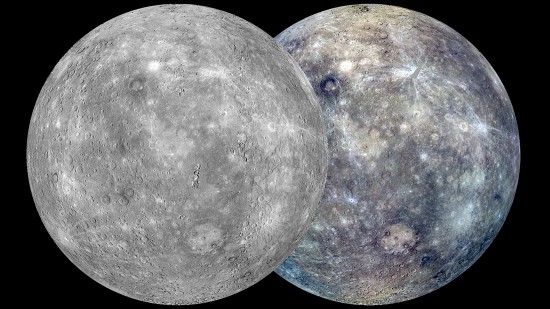Oct 1, 2015
After four years in orbit, MESSENGER is nearing the end of its life.
On August 3, 2004, NASA launched the Mercury Surface, Space Environment, Geochemistry and Ranging (MESSENGER) experiment from Cape Canaveral. After traveling nearly eight billion kilometers, the 485 kilogram spacecraft initiated orbital insertion around Mercury on March 17, 2011 and then began its scientific mission on March 23, 2011.
Sometime in April 2015, the spacecraft will end its life by crashing into Mercury’s surface. MESSENGER’s maneuvering propellant is slated to run out, so it will be sent skimming into a “hover orbit” until it finally reaches impact with the planet.
MESSENGER’s studies confirmed many things: Mercury is small, 4878 kilometers in diameter. Jupiter’s moon Ganymede and Saturn’s moon Titan are both larger. Mercury revolves at a mean distance of 57,910,000 kilometers from the Sun, so a year on Mercury lasts 88 days. Since it rotates once every 58.6 days, the planet completes three rotations for every two orbits.
Mercury, like most bodies in the Solar System, has a weak magnetic field, but scientists have no idea how it is generated. A magnetometer on the MESSENGER satellite could not resolve the problem of where the magnetic field originates. Modern theories suggest that it is a rotating “dynamo” of molten metal inside Mercury, although no one understands how a molten core exists on Mercury since it appears cold and dead. The molten interior should have cooled off eons ago.
Considering its estimated high density, Mercury is believed to be almost 75% iron surrounded by a thin shell of silicon-rich rock. Consensus theories about protoplanetary nebulae cannot explain the abundance of iron: the ratio of iron to silicon is opposite that of the other rocky planets.
Mercury’s temperature exceeds 400 Celsius at noon, and it receives an average of nine times more radiation at its surface than the Earth. Since it is bathed in searing heat, and is bombarded by charged particles from the Sun, how can it possess a detectable atmosphere?
According to planetary scientists, a planet with a gravity field only 38% that of Earth, and under such intense solar irradiation, should not possess the smallest remnant of an atmosphere. It is possible that Mercury could be a young planet, so, like Titan (a possibly young moon of Saturn), it retains some of its primordial envelope despite low gravity.
MESSENGER found electromagnetic flux tubes connecting the planet’s weak magnetic field directly to the Sun with gigantic filaments of electric current. In April of 2009, NASA’s THEMIS satellites found similar “electric tornadoes” above Earth at the interface between the magnetosphere and the Sun’s ionic wind.
Such currents are familiar to plasma physicists and Electric Universe proponents but were a surprise to planetary scientists. The presence of electric forces flowing like giant tornadoes into Mercury hint at a time when those forces might have been far more powerful.
One of the most intriguing features on Mercury is the Caloris Basin, a 1300-kilometer “astrobleme” that supposedly caused shockwaves to pass entirely through the planet. On the opposite side of Mercury are bizarre folds and uplifts that are said to be from the antipodal compression of the crust as the tremendous pressure partially melted and then re-solidified the strata. The Caloris Basin resembles other multi-ringed “impact” structures previously discussed in other Picture of the Day articles.
Multiple basins found on Mercury, just as on several other celestial bodies, are probably formed when electricity erodes material from the surface. Craters are usually circular because the electromagnetic forces constrain them to strike at right angles to the surface. If an electric arc is composed of two filaments rotating around a common center, the surface will be excavated by the plasma, leaving steep sides and a “pinched up” rim of debris. If several filaments are involved, the plasma beams can cut one crater within another, sometimes with one or more smaller craters on the rims.
Most of the debris on the surface of Mercury appears to be chunks of fallback material that was blown out by the explosive energies of plasma discharges. Ordinarily, as in the enlarged view of the image at the top of the page, the craters have little if any ejecta surrounding them.
Stephen Smith













